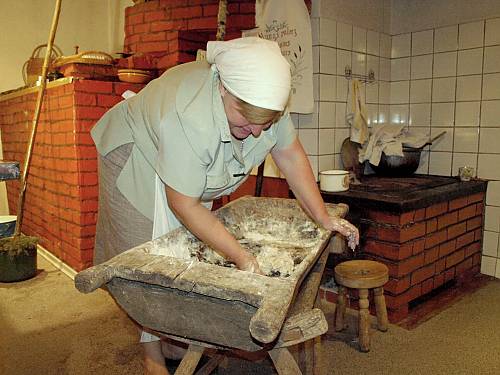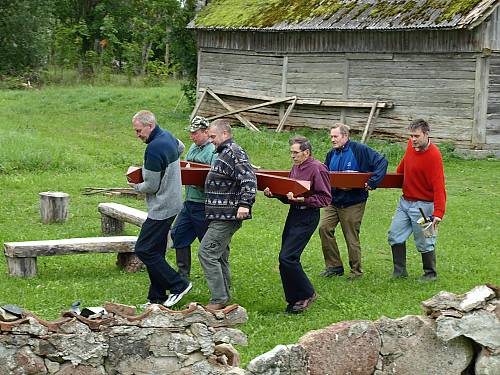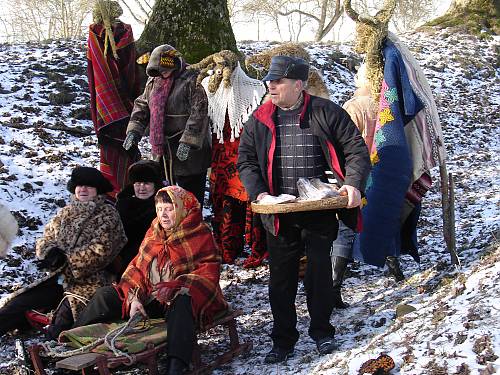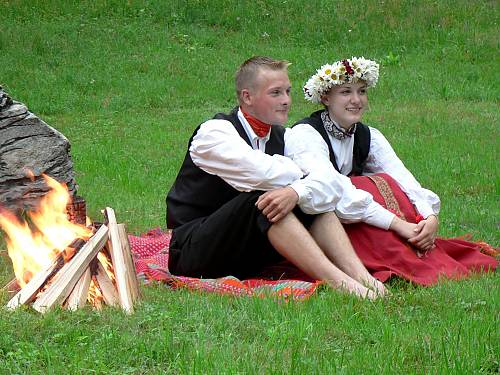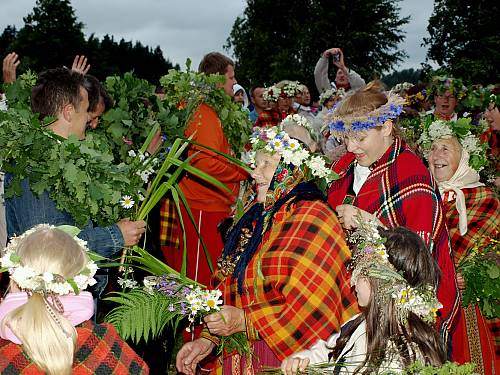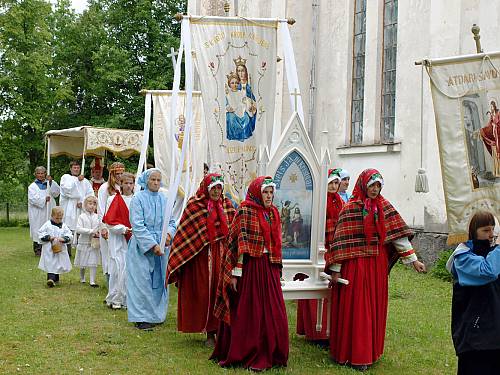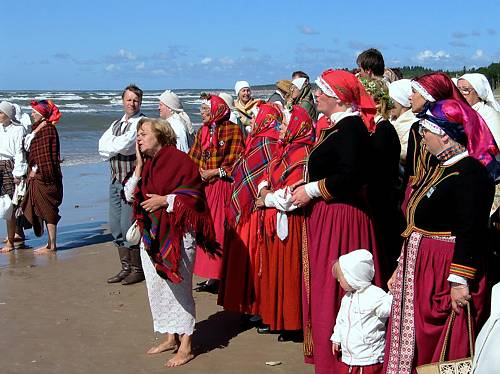Report on the status of an element inscribed on the list of intangible cultural heritage in need of urgent safeguarding
Cover sheet
State Party
Name of State Party
Latvia
Date of deposit of the instrument of ratification, acceptance, approval or accession
This information is available online.
Date of deposit of the instrument of ratification, acceptance, approval or accession
14-01-2005
Element inscribed on the Urgent Safeguarding List that is the subject of this report
Name of element
Suiti cultural space
Inscribed in
2009
Reporting period covered by this report
Please indicate the period covered by this report.
Reporting period covered by this report
01-10-2009 - 01-10-2013
Other elements inscribed on the Urgent Safeguarding List, if any
Please list all other elements from your country inscribed on the Urgent Safeguarding List, together with the year of inscription; for multinational elements, please indicate the other States concerned.
Executive summary of the report
Please provide an executive summary of the report that will allow general readers to understand the current status of the element, any positive or negative impacts of inscription, the implementation of safeguarding measures during the reporting period and their possible update for the following years.
Executive summary of the report
Intangible cultural heritage of the Suiti community includes traditional drone singing, folk songs and melodies, the Suiti dialect of Latvian language, annual festivities, cooking, wedding rituals, wearing traditional costumes, and the Catholic faith. Over the last years, the number of Suiti community has remained relatively the same, as about 2000 people living in the areas of Alsunga, Gudenieki and Jūrkalne, in the western part of Latvia that borders the Baltic Sea. However, the number of inhabitants of the Suiti land, as community uses to call it, has a tendency of decreasing, which may be explained by the socio-economic situation.
The international recognition for the Suiti cultural space has served as the basis for growing self-confidence and activity of the community to safeguard and develop its cultural traditions. The community involvement and interest to explore its cultural heritage is witnessed by folklore groups and ethnographic ensembles, dance groups and groups of interest in traditional crafts, and several active NGOs. Alongside to general preoccupation with safeguarding of the Suiti heritage, implemented by the Ethnic Cultural Centre (ECC) “Suiti” and the association “Suitu novads”, new NGOs have been established to favour education processes, research on the wearing of Suiti traditional costume and transmitting the skills of making it, as well as the acquisition of the Suiti dialect of Latvian language for children of pre-school age.
Children and youth have participated in safeguarding the Suiti heritage in different levels and types of education, involving pupils in research on their cultural traditions. The contribution and initiative of the youth has significantly increased, and also the older generation of the community takes more active part in cultural processes, sharing the experience and knowledge they have accumulated. Ethnographic ensembles and folklore groups have a special significance in strengthening the link between generations; and all generations participate in annual festivities – Festivity of Saint John the Baptist in Gudenieki, Saint Anne’s Day in Basi, Herb Day (Zāļu diena) in Jūrkalne and especially every autumn Saint Michael’s Festivity in Alsunga. The link that has historically emerged in Suiti culture between pre-Christian traditions and the Catholic faith has become stronger during the last years. It may be observed in religious practices and revitalisation of traditions, for example, May chants in honour of Saint Mary at crosses in farmsteads or at cross-roads, wearing of traditional costumes during services and festivities.
The openness of Suiti has given the possibility of getting acquainted with their heritage at exhibitions and festivities organised by cultural centres, as well as in the form of digital information resources, for example, www.suitunovads.lv. Several books dedicated to the Suiti culture have been published recently, and well received by readers. They allow becoming acquainted with the life stories of Suiti, their music-playing and cooking traditions.
During the preceding years, the determination and experience of Suiti to protect their heritage has grown. A continuous co-operation between the community, local governments and State authorities has been established, and the efficiency achieved under the conditions of limited availability of resources is commendable. The efforts to safeguard the cultural space have also stimulated the development of new co-operation initiatives of national and international scale, which gives an opportunity to get acquainted with the diversity of cultural heritage and to exchange on experiences, challenges and solutions for the safeguarding of intangible cultural heritage (ICH).
Contact person for correspondence
Provide the name, address and other contact information of the person responsible for correspondence concerning the report.
Title (Ms/Mr, etc.)
Ms
Family name
Maļkeviča
Given name
Evija
Institution/position
Latvian National Commission for UNESCO/ Communication and Information Programme Director
Address
Pils laukums 4-206, Rīga, LV-1050, Latvija
Telephone number
+371 67 325 109
Fax number
+371 67 222 762
E-mail address
office@unesco.lv
Other relevant information
B. Status of element inscribed on the Urgent Safeguarding List
Refer to the nomination file or to previous reports, if any, as the basis for reporting on the current status of the element, and report only on relevant changes since the date of inscription on the List or since the previous report. Nomination files, specific timetables and earlier reports, if any, are available at https://ich.unesco.org or from the Secretariat, upon request.
The State Party shall pay special attention to the role of gender and shall endeavour to ensure the widest possible participation of the communities, groups and, where applicable, individuals concerned as well as relevant non-governmental organizations during the process of preparing this report, and is asked to describe how it has done so in point D below.
B.1.
Social and cultural functions
Please explain the social and cultural functions and meanings of the element today, within and for its community, the characteristics of the bearers and practitioners, and any specific roles or categories of persons with special responsibilities towards the element, among others. Attention should be given to any relevant changes related to inscription criterion U.1 (‘the element constitutes intangible cultural heritage as defined in Article 2 of the Convention’).
Social and cultural functions
Suiti have a strong sense cultural identity and belonging to the community. Their cultural traditions and the land where these traditions are practiced are equally important to what is being named as the Suiti cultural space. Although only part of community members are actively involved in practice and transmission of cultural traditions – drone singing, playing traditional music instruments as kokle and bagpipes, traditional crafts and dancing, or other – the sense of belonging and interest in Suiti heritage is persistent also for other community members. Also wearing Suiti traditional costume is a source of pride and acknowledgment of belonging that is particularly manifest in various annual festivities. The safeguarding and transmission process largely relies on the shoulders of a few community members: leaders and participants of folklore groups and ethnographic ensembles, enthusiasts interested in transmitting traditional skills, and activists of local non-governmental organisations. Although this part of the community remains relatively small, the number of those actively involved in safeguarding traditions is increasing.
Safeguarding of the Suiti intangible cultural heritage also strengthens the link between generations. Involvement of the older generation in active social activities manifests appreciation of their experience and proficiency. Transmission of traditions is also a source of socialisation of children and youth, giving the sense of stability and trust in a lifestyle rooted in culture. While people of middle and younger generations have significant role in activities related to safeguarding of traditions, by taking active participation in activities of interest groups and NGOs (see Section B.3c).
Suiti community demonstrates an overall care for cultural heritage and personal co-responsibility, where interest in intangible heritage is complemented by due attention to the cultural environment – cultural centres of parishes as significant places of gatherings, and also churches and liturgical heritage. The belonging to Roman Catholic Church has an overarching significance for Suiti community, and various initiatives of revitalisation and recreation of Suiti intangible cultural heritage have been favoured by the church, and the dean of local parishes in particular. The sense of Suiti cultural identity has contributed to the self-confidence and willingness of the community to explore and safeguard their heritage and to develop local cultural environment. Heritage in the Suiti community is increasingly perceived as a resource for community development, including social equality, economic growth and sustainability.
B.2.
Assessment of its viability and current risks
Please describe the current level of viability of the element, particularly the frequency and extent of its practice, the strength of traditional modes of transmission, the demographics of practitioners and audiences and its sustainability. Please also identify and describe the threats, if any, to the element's continued transmission and enactment and describe the severity and immediacy of such threats, giving particular attention to any strengthening or weakening of the element’s viability subsequent to inscription.
Assessment of its viability and current risks
The intangible cultural heritage of Suiti, as drone singing, traditional festivities, wearing traditional costumes and other, is transmitted, and there are also tendencies of revitalisation of traditions. Several community members practice playing bagpipe again, and Suiti traditional dances are also being revitalised. However, according to the assessment by Suiti, there are several equally considerable and interconnected threats to the Suiti cultural space, to the cultural identity, and to the development and welfare of the community.
(A) Demographics and practitioners
Reduction in the number of inhabitants is observed, including outflow of the new generation to regional centres for the purposes of studies and work. Although they maintain awareness of the Suiti identity, it affects the circle of those actively practicing traditions and endangers their safeguarding in long-term.
Land selling and newcomers have also an influence. Such inhabitants arrive who do not relate themselves to the Suiti culture and do not establish cultural belonging; in turn, a part of them recognise the special meaning of the Suiti culture and become its active supporters and promoters.
(B) Modes of transmission
Transmitting cultural traditions in family is less characteristic as the living of three generations under the same roof does not serve as the basic model anymore, and for a part of inhabitants safeguarding of cultural traditions is not a priority. In turn, education and more active role of schools are emphasised. It stimulates reflection on the formal education content, activities of non-formal and interest education. It is necessary to attract and hold the interest of children and youth according to their age, taking into consideration new methods of education, and also the possibilities offered by new information technologies.
Taking into account the meaning of schools in transmitting cultural traditions, the Suiti cultural space depends on the State policy of education to a large extent - the provision of operation of such schools in which the number of pupils is small, motivation of teachers, including in terms of financial assistance.
(C) Socio-economic factors
Support to the economic development of the area is a priority of local governments, and, inter alia, inhabitants with low income and difficulties of supporting themselves and their family reside in the populated areas. Accordingly, it urges the local governments to direct a part of their funding for the social assistance. Economic development of the community is also related to the State regional policy where promotion of population density is felt to a large extent, neglecting more distant rural areas, which do not cluster around large regional centres. Such priorities for regional support are not always favourable to Suiti areas.
Financial support, including State financing, for the safeguarding activities is unreliable and insufficient and granted according to tendering procedures. This motivates the community to justify their ideas, however, it causes unpredictability and insecurity regarding the funding granted and the future safeguarding activities.
B.3.
Implementation of safeguarding measures
Please report on the safeguarding measures described in the nomination file, and previous report, if any. Describe how they have been implemented and how they have substantially contributed to the safeguarding of the element during the reporting period, taking note of external or internal constraints such as limited resources. Include, in particular, information on the measures taken to ensure the viability of the element by enabling the community to continue to practise and transmit it. Include the following detailed information concerning the implementation of the set of safeguarding measures or safeguarding plan:
B.3.a.
Objectives and results
Indicate what primary objective(s) were addressed and what concrete results were attained during the reporting period.
Objectives and results
Primary objectives and activities for safeguarding of the Suiti cultural space were stated in the nomination, and results have been achieved in relation to each of them.
(1) To enhance and ensure preservation of the Suiti ICH and its transfer at the levels of pre-school, general, interest and vocational education, as well as through lifelong learning.
Pre-school children are introduced to traditional Suiti music, and local cultural studies are established as optional in general education. Pupils are involved in the cultural research work, and Suiti traditions are introduced in music and visual art studies. The camp “Suitu tradīciju skoliņa” [The Little School of Suiti Traditions], organised each summer for children and youth, has attracted increasing interest. Meanwhile, folklore groups, ethnographic ensembles and dance groups contribute significantly for bringing different generations together.
(2) To ensure urgent safeguarding measures for protection, revitalisation and popularisation of the endangered elements of the Suiti ICH.
The significance of wearing a traditional costume, inter alia, for services, has become stronger, and the number of those acquiring the skills of making costumes has increased significantly. Certain traditional forms of music have been revitalised, and Suiti ethnographic ensembles have introduced the use of drone singing in religious chants.
(3) To facilitate research and publicity about the Suiti ICH.
Owing to the initiative of the community, a massive accumulation of testimonies of the Suiti cultural heritage, including ancient elements of the traditional costume, handiworks, has been commenced, surveying the testimonies kept at Suiti homes, stocks of archives and museums. “Suitu mantojuma krātuve” [Suiti Heritage Repository] has been opened in premises of the ECC “Suiti”, offering tangible testimonies of the Suiti culture for public display. In 2010 the third international drone singing festival took place.
(4) To ensure recovery and restoration of buildings representing historic and cultural value necessary for activities of preservation and popularisation of the Suiti ICH.
During the reporting period the renovation of the Alsunga Livonian Order Castle - important Suiti cultural centre - was commenced and the castle is open to visitors, Basi and Jūrkalne cultural centres have been completely renovated, and renovation of the interior of Alsunga cultural centre has been performed, thus restoring significant centres of Suiti cultural life for the acquisition, practising and promotion of Suiti ICH expressions.
(5) To ensure long-term sustainability of the Suiti cultural space.
During the preceding four years activities in relation to long-term safeguarding of the Suiti cultural space, under the conditions of limited financial resources, were mainly implemented in the field of preservation of the cultural environment and protection of sacred heritage. Restoration of Suiti churches as buildings of cultural and historical significance and the cultural values therein were supported, and several cultural objects existing in the Suiti cultural space were recognised as cultural monuments.
B.3.b.
Safeguarding activities
List the key activities that were carried out during this reporting period in order to achieve these expected results. Please describe the activities in detail and note their effectiveness or any problems encountered in implementing them.
Safeguarding activities
Safeguarding activities of the Suiti cultural space during the reporting period were directed towards achieving the primary objectives as stated (see Section B.3a).
(1)
Pre-school children have opportunity to acquire kokle-playing (since 2012), mostly based upon contribution of a local tradition bearer. Alsunga Secondary School joined the UNESCO Associated Schools Project Network (2009–2011) focusing on safeguarding of ICH – pupils and teachers participated in seminars and expeditions. Suiti local cultural studies were introduced in school curriculum, every year being acquired by on average 40 pupils. Methodical materials and textbooks are currently being drawn up. Suiti culture is integrated in several subjects – the Latvian language and literature, history of Latvia, geography, culturology, housekeeping and technologies, visual art, music, social sciences, as well as class meetings. However, it is difficult to find appropriate time in curricula for getting acquainted with Suiti cultural elements. Playing of ethnographic kokle was introduced in Alsunga Music School in 2010 in co-operation with Jāzeps Vītols Latvian Academy of Music, and 8 instruments – kokles – were ensured. In turn, the course “Traditional Culture” was integrated in visual art studies, applying innovative methodology.
Each year summer camp for children and youth “Suitu tradīciju skoliņa” [The Little School of Suiti Traditions] is organised, and on average 30 children and young persons mainly from amongst Suiti participate therein. The school offers to acquire Suiti traditions and history by going to museums and having practical lessons. The camp has boosted the interest of children and youth, as well as parents.
Involvement of children and youth in folklore and dance groups is active – they are participating in festivities, concerts and competitions. Suiti ethnographic ensembles and dance groups have vast performance experience in local annual and religious festivities and international folklore festivals. Suiti ethnographic ensembles are very recognisable in Latvia. The performance of liturgical chants in drone singing introduced by Suiti has become popular and performed by the ensemble “Suitu sievas” in various places in Latvia. New participants joined “Suitu sievas”, in turn, the number of participants of ensembles “Gudenieku suiti” and “Maģie suiti” has reduced, due to the change of generations, and decrease of the number of local residents.
(2)
The summer solstice traditions and festive gatherings, services and concerts have been jointly organised in Alsunga, Jūrkalne, Gudenieki as well as Basi. Country band “Suitu muzikanti” was created in Alsunga in 2010, restoring the traditional forms of playing music in annual and town festivities. In turn, traditional ensemble “Basu suiti” commenced activities in Basi in 2011. Due to insufficient human and financial resources tradition of playing bagpipes has not been restored, however, certain self-instruction training has been commenced.
Suiti wedding traditions are mainly practised in the activities of ethnographic ensembles. Interest regarding Suiti wedding traditions is observed also outside the community, however, it is less consistent in the community itself, and weddings based on Suiti traditions is rather rare within the scope of the Suiti cultural space.
Creative workshop “Austuve” in Alsunga increased the number of looms, traditional costumes are made, including for local dance groups of children and youth, as well as middle generation. Association “Suitu amatnieki” has organised Suiti traditional costume workshops – sowing of bonnets (aube), knitting of socks, making of pearled collars and wristbands (dūrgali). Permanent exposition of Suiti costumes in Alsunga Museum, and several exhibitions dedicated to Suiti handiwork were organised.
(3)
“Suitu mantojuma krātuve” [Suiti Heritage Repository] established by the ECC “Suiti” includes the elements of Suiti traditional costume, and on that basis a detailed publication regarding its wearing practice will be issued. Educating seminars and exhibitions of works of Suiti artisans have been organised, including in community festivities. As for singing traditions, the third international drone singing festival took place in 2010. Comparatively small funding was available for organising it, and it would be preferable to attract wider attendance. The next festival is planned in 2014.
During the last four years, several publications on the Suiti culture have been issued, namely on kokle playing traditions, pupils' participation in field work on Suiti culture, Suiti culinary heritage and dialect use. A catalogue of Suiti traditional costumes is being prepared, and several videos regarding Suiti annual and religious festivity – Saint Michael’s Day – have been taken and shown on the Latvian Television. List of publications see at: http://www.suitunovads.lv/lv/gramatas_un_publikacijas/.
As for periodicals, a column “Suiteņu stāsti” is published in Suiti dialect of Latvian language in the monthly issue “Alsungas ziņas”, available to the inhabitants of Alsunga municipality. Cultural events of Jūrkalne and Gudenieki are reflected in newspapers of the relevant municipalities once a month. The idea regarding a single monthly issue for the Suiti cultural space has not been carried out. However, it depends on the level of interest, co-operation and financial investment of relevant local governments.
(4)
The research and renovation of Alsunga Livonian Order Castle was commenced in 2010, and the castle offers informative excursions. Due to the limited financial resources the progress of rescue operations of the castle is slow, and the premises may become dangerous. In 2010 Basi Cultural Centre was renovated, and in 2011 – Jūrkalne Cultural Centre, in turn the internal renovation of Alsunga Cultural Centre was completed in 2012. Additional funding would be necessary for complete renovation of Alsunga Cultural Centre and to landscape its surrounding territory.
(5)
The intended State programme for safeguarding and long-term development of the Suiti cultural space was not established, however, the development of roads of local significance is planned for the upcoming years. In 2013 an initiative has been expressed to the State Culture Capital Foundation to establish a programme for supporting the Suiti culture. As regards developing cultural environment of the Suiti community, restoration of Suiti churches – Saint Michael’s Catholic Church in Alsunga, Saint John’s Roman Catholic Church in Gudenieki and Saint Joseph’s Roman Catholic Church in Jūrkalne – was continued. Community participated in landscaping of the church territories. The cultural values of churches – including altarpieces, chapels, organs, wood carvings, chandeliers – were gradually restored.
B.3.c.
Participation of communities, groups or individuals in the safeguarding activities
Describe how communities, groups or, if appropriate, individuals as well as relevant non-governmental organizations have effectively participated, including in terms of gender roles, in the safeguarding measures. Describe the role of the implementing organization or body (name, background, etc.) and the human resources that were available for implementing safeguarding activities.
Participation of communities, groups or individuals in the safeguarding activities
In long-term ethnographic ensembles and folklore groups have had large influence on the Suiti cultural space. Also interest groups of the safeguarding of Suiti craft skills should be mentioned. In Alsunga – ethnographic ensemble “Suitu sievas” (founded in 1955, 17 participants), middle generation dance group “Suiti” (1982, 18), children’s and youth folklore group “Suitiņi” (1985, 8), three children’s and youth folk dance groups, country band “Suitu muzikanti” (2010, 8) and creative workshop “Austuve” (6 participants). In Jūrkalne – ethnographic ensemble “Maģie suiti” (1959, 13). In Gudenieki – ethnographic ensemble “Gudenieku suiti” (1965, 16), tradition ensemble “Basu suiti” (2011, 9), children’s and youth folklore group “Krētainie suiti” (2002, 15).
Non-governmental organisations have emerged in the Suiti community, and they take active part in safeguarding Suiti traditions in their own profile of safeguarding activities.
(A) The ethnic cultural centre “Suiti”, founded in 2001 with the objective to promote the Suiti as ethnic community and the safeguarding, protection and balanced development of Suiti cultural and historical heritage. The centre implements a series of activities, and is the main representative of the community in communication with State authorities. Local governments, the area of which covers the Suiti cultural space, are also members of the centre, and in total the centre has 52 members.
(B) The association “Suitu novads” was founded in 2007 with an objective to achieve the creation of a united Suiti municipality. Its membership includes 30 community members, and one of its activities is research on the Suiti cultural space. The association is the main creator and maintainer of the informative site of the Suiti community www.suitunovads.lv.
(C) The association “Suitu amatnieki” was founded by 13 artisans in 2011. It was created with the objective to promote craft in Suiti cultural space, Latvia and around the world, and to safeguard the Suiti cultural heritage. Since the creation thereof the association has implemented several activities in the acquisition of crafts, and they have been well received by the Suiti community.
(D) The association “Cultural Education Centre “Riekstiņpļava”” was founded in 2012 with the objective to promote the cultural education processes in Latvia by organising educating activities both for children and youth and for adults and seniors. One of the tasks of the association is to promote sustainability of Suiti heritage. The association is currently working on digital textbook on Suiti culture.
(E) The association “Spārni Alšvangā” was founded in 2013 with the objective to develop initiatives for pre-school educational institutions, as well as to promote adult lifelong education. Upon initiative of the association a book for children of pre-school age “Suitu Miķelīša mazā ābece” was issued for the acquisition of Suiti dialect of Latvian language.
Significant contribution to safeguarding of the Suiti cultural heritage has been made by parishes of the Roman Catholic Church – parish of Saint Michael’s Alsunga Catholic Church, parish of Saint Joseph’s Jūrkalne Catholic Church and parish of Saint John the Baptist Gudenieki Catholic Church which contribute to the cultural identity of the community and the restoration of material cultural heritage of churches.
B.3.d.
Timetable and budget
Indicate in a timetable when each activity was implemented and the funds that were used for its implementation, identifying the source of funding for each (governmental sources, in-kind community inputs, etc.).
Timetable and budget
Timetable and budget refer to the safeguarding plan provided and, considering numerous activities implemented, is demonstrated for the activities under the respective objectives (see B.3a). The budget is indicated rounding up in EUR and displaying the total amount for the reporting period. Involvement of the community not financially compensated is mentioned, although this contribution cannot be entirely measurable in terms of money.
(1)
To teach playing the kokle at the preschool level; to introduce a specific ICH curriculum and to integrate elements of Suiti ICH into the existing curricula (history, music, etc.) at Suiti community schools; to launch a new curriculum for playing traditional musical instruments at Alsunga Music School; to organize regular ICH summer schools for Suiti children; to ensure operation of Suiti children and adult folk and dance groups. / Since 2009. / Community, 400 – ECC „Suiti”, 200 – association „Spārni Alšvangā”, 8 100 – Alsunga municipality, 2 100 – Ventspils municipality, 1 900 – Kuldīga municipality, 27 600 – State budget and earmarked grant, 6 900 – State Culture Capital Fund, 2 300 – Latvian National Commission for UNESCO (financial assistance of the UNESCO Participation Program), 33 500 – European Regional Development Fund.
(2)
To restore traditional ways of celebrating summer solstice, of making of Suiti traditional costumes in the community and facilitate their wearing; to organize and support a band of traditional Suiti musicians; to organize for community members a training course of bagpipe playing. / Since 2009. / Community, 1 300 – ECC „Suiti”, 3 500 – Alsunga municipality, 5 600 – Ventspils municipality, 1 100 – Kuldīga municipality, 7 800 – State Culture Capital Fund, 1 100 – Mortgage and Land bank of Latvia, 1 000 – the Netherlands KNHM Fund.
(3)
To organize studies and research of the Suiti ICH; to record, compile and map geographic place names; to digitalize data from the old Suiti church registers and recorded Suiti folk songs; to prepare publications in the Suiti dialect of Latvian language; to develop the Suiti community web page: www.suitunovads.lv; to produce a TV documentary; to organize the International Drone Singing Festival. / Since 2010. / Community, 100 – ECC “Suiti”, 2 400 – Alsunga municipality, 700 – Kuldīga municipality, 700 – Ventspils municipality, 11 400 – State Culture Capital Fund, 1 100 – Latvian National Commission for UNESCO (financial assistance of the UNESCO Participation Program), 7 400 – private donors, including enterprises.
(4)
To start restoration of the Alsunga medieval castle and to restore Basi and Jūrkalne cultural centers. / 2010–2012. / Community, 52 900 – Alsunga, 184 300 – Ventspils, 122 400 – Kuldīga, 600 – State Culture Capital Fund, 6 400 – State Inspection for Heritage Protection (15 700 – since 2005), 459 100 – European Union funds.
(5)
To support restoration of Suiti religious buildings. / Since 2009. / Community, 19 100 – parishes, 6 200 – State Culture Capital Fund, 1 100 – Mortgage and Land bank of Latvia, 4 600 – the Netherlands KNHM Fund.
In total: (A) financing of local governments – EUR 385 100, (B) state financing – EUR 60 600; (C) international financing – EUR 501 600.
B.3.e
Overall effectiveness of the safeguarding activities
Provide an overall assessment of the effectiveness of the activities undertaken to achieve the expected results and of the efficiency of the use of funds for implementing the activities. Please indicate how the activities contributed to achieving the results and whether other activities could have contributed better to achieving the same results. Also indicate whether the same results could have been achieved with less funding, whether the human resources available were appropriate and whether communities, groups and individuals could have been better involved.
Overall effectiveness of the safeguarding activities
After the nomination was inscribed in the UNESCO Urgent Safeguarding List, the safeguarding activities have significantly complemented each other, and mutual stimulation for new initiatives was observed – non-governmental organisations have become more active, home production develops, etc. Suiti have strived to put their knowledge and skills to use, for example, in the field of education and research, in making of traditional costumes, playing instruments, etc. Also the skills in project development and attraction of investments have improved, as well as ability of the community to determine priorities, ideas and to attract funding for implementation.
During the preceding years Suiti have established co-operation with other communities in Latvia (for example, with Rucava women in acquisition of traditional handiwork) and outside Latvia (particularly with Kihnu cultural space and Seto community in Estonia). Such co-operation has become a valuable gain for getting-to-know of cultures, exchange of experience and strengthening of the community, as well as attracting international funding.
Although the funding attracted during the reporting period did not reach the planned amount, the contribution of the implemented activities for safeguarding of the Suiti cultural space should be recognised. Taking into account the limitedness of the financial resources available and the general competition for attracting funding for cultural projects, the utilisation of the funding was as efficient as possible, and majority of activities was based on self-investment by community members, and the same results could not have been achieved utilising smaller amount of resources. The results of safeguarding activities are influenced by several challenges.
(A) Human resources of the community are limited, and contribution of each person is significant. Therefore, the inability of any person to continue work is a loss for the process of transmission of heritage. People outside the community were engaged in implementation of individual activities (for example, teaching of kokle-playing in Alsunga Music School, seminars with participation of experts regarding traditional costumes, etc.), however, the motivation for their contribution is less enduring, and accordingly the community chose to sustain its own human resources and also to involve them, for example, in educational initiatives (kokle-playing in Alsunga pre-school education).
(B) It is necessary to ensure succession for the planned activities. If an activity commenced is not continued due to financial or other considerations, it cannot achieve the anticipated result. Thus, for example, in case of Suiti municipality studies the initial financial support for the development of a curriculum is still pending for continuation in the form of publishing a textbook, therefore, activities do not have immediate efficient yield and their implementation process is lengthy and gradual.
(C) The heritage safeguarding activities implemented by the community are mainly based on specific and short-term activities' projects, with an accordingly focused financial investment. It allows carrying out of individual initiatives, however, a more stable and financially more extensive support programme would be preferable for purposeful long-term safeguarding of the Suiti cultural space, which would promote significance of safeguarding the cultural space and provide the community with an opportunity of planning its development in a more far-reaching way.
B.4. Community participation
Please describe how communities, groups and individuals, as well as relevant non-governmental organizations have been involved, including in terms of gender roles, in updating the safeguarding plan, and how they will be involved in its implementation.
Community participation
Safeguarding of the Suiti cultural space is based on the initiative and contribution of the community. Although not whole community is active in safeguarding cultural identity and traditions, the community has interest in the implemented initiatives – celebration of traditional festivities and religious festivities, traditional music concerts, handiwork workshops, exhibitions, etc. New non-governmental organisations, for example, the association “Suitu amatnieki”, the association “Cultural Education Centre “Riekstiņpļava”” and the association “Spārni Alšvangā”, interest groups, as well as the creative workshop “Austuve” and country band were founded. Their activity includes joint playing music, improvement of craft skills, particularly making of the Suiti traditional costume. Linking of traditions and contemporary cultural processes is also the result of active work of non-governmental organisations in developing the cultural environment. The investment of non-governmental organisations may be observed in research development, and the community has become the most significant explorer of its culture. For particular commitment to the safeguarding of the Suiti cultural space, in 2011 Grigorijs Rozentāls, leader of the association “Suitu novads”, and previously – recognised tradition bearers of the community Ilga Leimane in 2009 and Lidija Jansone in 2008 – received the Order of Three Stars of the Republic of Latvia.
The Roman Catholic Church and particularly the contribution of the dean of Alsunga, Jūrkalne and Gudenieki parishes Andris Vasiļevskis, is important for strengthening the cultural identity and cultural environment of the community, favoring the involvement of the community in safeguarding traditions and the cultural environment (May chants at crosses, restoration of the old crosses and making and erecting of new crosses, involving of youth in taking care of the surroundings of a church, personal professional advice in textile arts and improvement of weaving skills, promotion of wearing the traditional costume, etc.). In 2013 the dean received the Annual Cultural Heritage Award of Latvia in nomination “Labākais saimnieks” [Best Host]. The support of the Roman Catholic Church has stimulated firmer incorporation of Suiti cultural traditions in religious practices of the community. i.e., the drone singing practised by Suiti has become an essential part in catholic services in the Suiti community and the traditional chant is used as the basis for chanting religious texts. Suiti have also performed in churches and services elsewhere in Latvia, and in autumn 2013 such practice was highly appreciated by the archbishop-metropolitan of the Roman Catholic Church in Latvia Zbigņevs Stankevičs who visited the Suiti community for the first time in Saint Michael’s festivity and encouraged to appreciate the link between traditions and creativity.
The Suiti are persistently determined to safeguard their cultural space. ECC “Suiti” initiated community discussions on further safeguarding priorities, and a community plan for subsequent years was drawn up. Concurrently to remaining safeguarding priorities (activities of ethnographic ensembles, interest groups, drone singing festival, etc.), several additional activities are intended (acquisition and development of playing bagpipes, publishing of Suiti cultural space textbook, creation of an open-air museum, development of the infrastructure, etc.), as well as entirely new initiatives (for example, development of Suiti craft product brand).
B.5. Institutional context
Please report on the institutional context for the local management and safeguarding of the element inscribed on the Urgent Safeguarding List, including:
- the competent body(ies) involved in its management and/or safeguarding;
- the organization(s) of the community or group concerned with the element and its safeguarding.
Institutional context
The institutional context of safeguarding the Suiti cultural space should be viewed in two basic levels – State and community, including local government, level, and institutions with the relevant functions and competences are involved in each of them.
(A) State administrative institutions
UNESCO Convention for the safeguarding of the ICH, including preoccupation with elements included in international lists, is within the competence of the Ministry of Culture of the Republic of Latvia (www.km.gov.lv). The Latvian National Centre for Culture (www.lnkc.gov.lv) is subordinated to the Minister for Culture, and one of directions of its operation is to implement the State policy in the field of ICH, and it supervises cultural education issues. In turn, implementation of the Convention and safeguarding of ICH is promoted by the Latvian National Commission for UNESCO (www.unesco.lv), providing support to policy-making, activities related to safeguarding the heritage thereof. The work of educational institutions is of great importance to safeguarding of the Suiti cultural space, thus co-operation with the Ministry of Education and Science of the Republic of Latvia (www.izm.gov.lv) and the National Centre for Education (www.visc.gov.lv) subordinated thereto was established.
The main instrument of State financial support available for safeguarding activities of ICH is the State Culture Capital Foundation (www.kkf.lv), which has a separate traditional culture sector that examines projects dedicated to safeguarding of ICH. Support is also provided through regional programmes of project competitions, which are directed directly towards local cultural activities in regions of Latvia. Taking into account the link between intangible and tangible cultural heritage in safeguarding the Suiti cultural space, including preoccupation with cultural environment and safeguarding of cultural monuments, the State Inspection for Heritage Protection (www.mantojums.lv) should also be mentioned, and its task is to implement the State policy in the field of material cultural heritage and accordingly preoccupation with activities related to heritage protection.
Also such State administrative institutions should be mentioned in addition to State authorities competent in the field of culture, which are of significance to regional development and directly influence the areas of the Suiti cultural space, i.e., the Ministry of Environmental Protection and Regional Development (www.varam.gov.lv), which develops the State policy in regional development issues, the Ministry of Transport (www.sam.gov.lv), the competence of which includes policy-making and resulting decisions in road infrastructure issues, as well as the Ministry of Agriculture (www.zm.gov.lv) and the Rural Support Service (www.lad.gov.lv).
(B) Local government institutions
The Suiti cultural space is located in the territories of three local governments: in Alsunga municipality (www.alsunga.lv), Jūrkalne rural territory of Ventspils municipality and Gudenieki rural territory of Kuldīga municipality, and the contribution of each referred-to local government is the provision of activities of educational institutions, support to interest education and culture events, as well as contribution to municipality infrastructure.
(C) Institutions within the community
Several groups of institutions provide significant contribution to safeguarding the Suiti cultural space within the community, confirming the significance of non-governmental organisations and interest groups, and religious organisations accordingly.
Currently several non-governmental organisations are actively involved in safeguarding of ICH of the Suiti cultural space, and particularly the contribution of the ethnic culture centre “Suiti” and the association “Suitu novads” (www.suitunovads.lv) should be mentioned in implementing the measures for safeguarding and development of the cultural space and in protecting Suiti interests in State and local scale policy-making. During the preceding years new Suiti non-governmental organisations have been created in addition to the referred-to organisations, and they purposefully enrich the range of activities of Suiti culture (see Section B.3c of the report).
It is important to mention the contribution of Roman Catholic Church in Latvia (www.catholic.lv) and particularly of the dean of Alsunga, Jūrkalne and Gudenieki parishes in safeguarding the Suiti cultural space and strengthening the cultural identity of the community. Residents view the support of the church with great appreciation and gratitude.
After inscribing the Suiti cultural space in the international List of Intangible Cultural Heritage in Need of Urgent Safeguarding, in January 2010 several stakeholders involved signed the letter of intent on co-operation in safeguarding of the Suiti cultural space, and it was the ethnic cultural centre “Suiti”, Alsunga Municipality Council, Kuldīga Municipality Council, Ventspils Municipality Council, the Ministry of Culture and the Latvian National Commission for UNESCO. It is intended to supplement the letter of intent by involving the Ministry of Education and Science, the Ministry of Environmental Protection and Regional Development and the Ministry of Transport.
B.6. Participation of communities in preparing this report
Describe the measures taken to ensure the widest possible participation of the communities, groups and, where applicable, individuals concerned as well as relevant non-governmental organizations during the process of preparation of this report.
Participation of communities in preparing this report
The Suiti community was involved in drawing up of this report from the beginning and continuously during revision thereof. The report is based on information provided in the report prepared by the ECC “Suiti” on activities, which were implemented for safeguarding of the Suiti cultural space during the time period from 2009 until 2013, on partners involved, funding and evaluation of results.
Report discussions gathered Suiti community (representatives of non-governmental organisations and active community members), Roman Catholic Church dean, local governments (Alsunga, Ventspils and Kuldīga municipalities) and representatives of State authorities (the Ministry of Culture, the Latvian National Centre for Culture, the Latvian National Commission for UNESCO, and the Ministry of Education and Science, the Ministry of Environmental Protection and Regional Development). In 2013 meetings took place on 7 February 2013, 23 April 2013, 18 June 2013, and 27 September 2013. The meeting in Alsunga on 23 April 2013 was as a visiting meeting of the Education, Culture and Science Commission of the parliament Saeima of the Republic of Latvia. In turn on 21 May 2013 meeting with the referred-to commission took place in Riga.
The report was prepared in Latvian – entirely spoken within the Suiti community – and thus accessible for exchange of opinions. In order to discuss its first revision, meetings of the Suiti community were organised in Alsunga, Jūrkalne and Gudenieki on 17 and 18 October 2013. The opinions and proposals of the community were taken into account in drawing up the final revision of the report.
C. Signature on behalf of the state party
The report should conclude with the original signature of the official empowered to sign it on behalf of the State, together with his or her name, title and the date of submission.
Name
Dace Melbārde
Title
Ms, Minister for Culture of the Republic of Latvia
Date
14-12-2013
Signature



